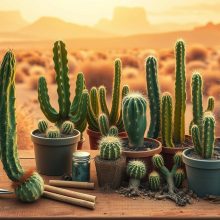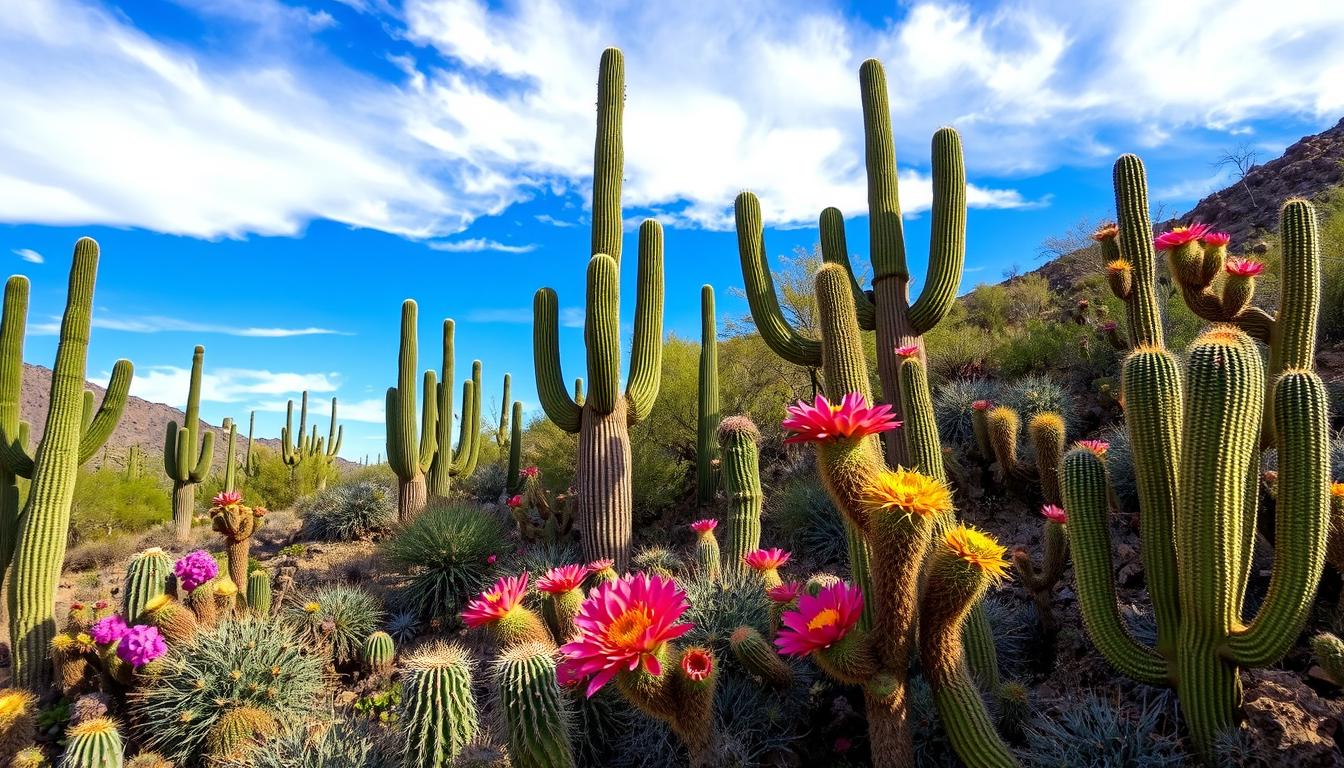How to Make the Perfect Cactus Potting Mix at Home
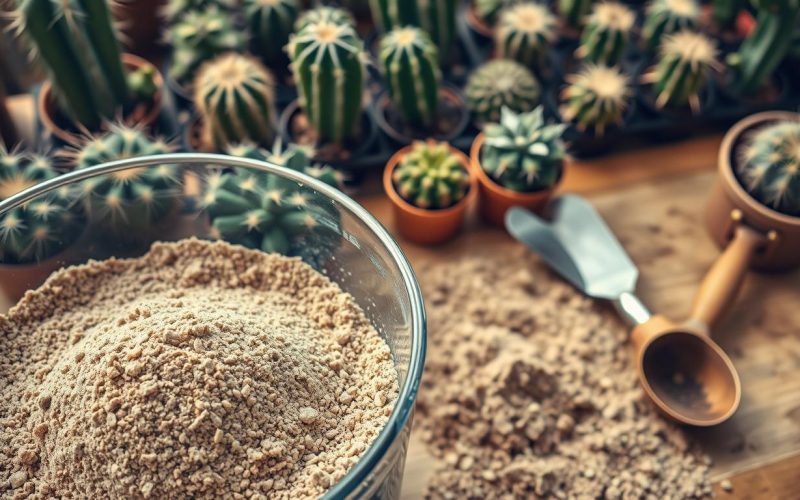
Growing healthy cacti starts with the right soil. Standard potting soil can harm these plants. They need special drainage and nutrients.
Creating the perfect cactus potting mix is an art. It turns ordinary gardening into a success. This mix is key for growing cacti well.
A premium succulent soil is more than basic gardening. It meets cacti’s unique desert habitat needs. The best mix drains water fast, prevents root rot, and has little organic content for strong growth.
Key Takeaways
- Cacti require specialized soil different from standard potting mixes
- Drainage is the most critical factor in desert plant soil composition
- Homemade cactus potting mix can be more cost-effective than store-bought options
- Understanding soil components prevents common plant health issues
- Proper soil mix supports long-term cactus survival and growth
Understanding Cacti and Their Soil Requirements
Cacti are amazing plants that have learned to survive in tough places. They are very strong, but they need special care, like the right soil.
To make the best soil for cacti, we need to know where they come from. They live in dry places with little rain and very hot or cold temperatures. This affects what kind of soil and nutrients they need.
The Natural Habitat of Cacti
Deserts shape cacti’s special features. Their homes are usually:
- Rocky, mineral-rich terrain
- Little organic matter
- Soil that drains water well
- Rain that comes in short, strong bursts
Why Drainage is Crucial
Drainage is key for cacti soil. These plants store water in their stems and leaves. If the soil is too wet, they can get root rot. A good soil mix lets water drain, just like in their natural habitats.
Nutrients Needed for Healthy Growth
Cacti don’t need much food compared to other plants. Their soil should be light, with little organic stuff. Important nutrients include:
- Little nitrogen
- Some phosphorus
- Small amounts of trace minerals
- Very little organic matter
Knowing these basics helps gardeners create the best spot for cacti to grow and stay healthy.
Key Components of a Cactus Potting Mix
To make the best succulent potting substrate, you need to know the key ingredients. A good mix has both organic and inorganic parts. These help with drainage and give nutrients.
For a top-notch sandy cactus compost, pick materials that feel like the desert. Each part is important for keeping cacti healthy and stopping root rot.
Coarse Sand: A Must-Have Ingredient
Coarse sand is key for good drainage in cactus soil. It’s different from fine sand because it lets air in. This stops water from drowning the roots.
- Select sand with larger particle sizes
- Avoid beach or fine-grain sand
- Recommended ratio: 30-40% of total mix
Perlite vs. Pumice: Which is Better?
Perlite and pumice both help with air and water in your soil. But, they’re not the same. They suit different cacti needs.
- Perlite: Lightweight, white volcanic rock
- Pumice: Denser, more natural-looking material
- Recommended usage: 20-30% of total mix
Organic Matter: Benefits and Options
Organic parts in your soil mix give nutrients and hold a bit of water. Choosing the right ones is crucial for a balanced mix.
- Recommended organic materials:
- Coconut coir
- Bark chips
- Aged compost
- Limit organic content to 10-20% of total mix
How to Choose the Right Soil Mix
Choosing the right cactus potting mix is key for healthy plants. Each cactus needs its own soil mix to thrive. A mix that drains well is crucial to prevent root rot and keep plants healthy.
- Plant species and native habitat
- Local climate conditions
- Drainage requirements
- Nutrient needs
Factors to Consider for Specific Cacti
Every cactus needs a special soil mix. Desert cacti need a mix with more minerals than tropical ones. The best mix drains well and has little organic matter.
Commercial Options vs. Homemade Mix
Gardeners must decide between store-bought and homemade soil. Commercial mixes are easy to find, but homemade mixes let you control the ingredients. A good mix can make your plants grow better and live longer.
- Commercial mixes: Quick, standardized solution
- Homemade mixes: Customizable, cost-effective
- Tailored to specific cactus requirements
Knowing what your cactus needs will help you pick the best soil. This ensures your plants grow strong and live a long life.
Step-by-Step Guide to Making Your Own Mix
Making your own desert plant soil mix is simpler than you might think. A good mix helps cacti stay healthy and prevents root rot. The right mix can greatly improve your plant’s growth and survival.
Improving your garden begins with knowing what desert plants need. Cacti have special soil needs that are different from regular houseplants.
Gather Your Materials
Start by gathering these ingredients for your desert plant soil:
- Coarse sand
- Potting soil
- Perlite or pumice
- Pine bark (optional)
- Large mixing container
- Gardening gloves
- Measuring cup
Combining Ingredients
The perfect mix for cacti growth has a specific ratio. Here’s a suggested mix:
- 3 parts standard potting soil
- 3 parts coarse grit or sand
- 1 part perlite
- 1 part pine bark (for extra drainage)
Testing the Mix for Quality
Test your mix by pouring water through it. See how fast it drains. Good cactus soil drains water quickly, like desert soil.
Your homemade desert plant soil is now ready. It supports healthy, thriving cacti with great drainage and nutrients.
Ensuring Proper Drainage in Your Mix
Drainage is key for any cacti growing medium. Succulents and cacti love dry soil, where water drains fast. This stops water from harming their roots, which can cause root rot.
To make a good drainage system for your succulent mix, follow these steps:
- Select containers with drainage holes
- Use lightweight, porous materials
- Create multi-layer drainage solutions
- Avoid water-retaining materials
Understanding Drainage Layers
For a healthy cactus, it’s important to know how water moves through soil. A good drainage layer lets water go away fast. This is like the desert where cacti live.
Choosing the Right Pot
The right pot is important for drainage. Terra cotta and unglazed ceramic pots are best. They let moisture out through their walls. Stay away from plastic pots that hold water and make it too humid for cacti.
- Terra cotta pots provide natural breathability
- Unglazed ceramic absorbs excess moisture
- Avoid plastic containers that retain water
Using these drainage tips will help your cacti grow well. It will also stop problems caused by too much moisture.
The Role of pH in Soil Health
Understanding soil pH is key to making the best cactus potting mix. Cacti love soil that’s like their desert home. The right pH helps your plant grow well.
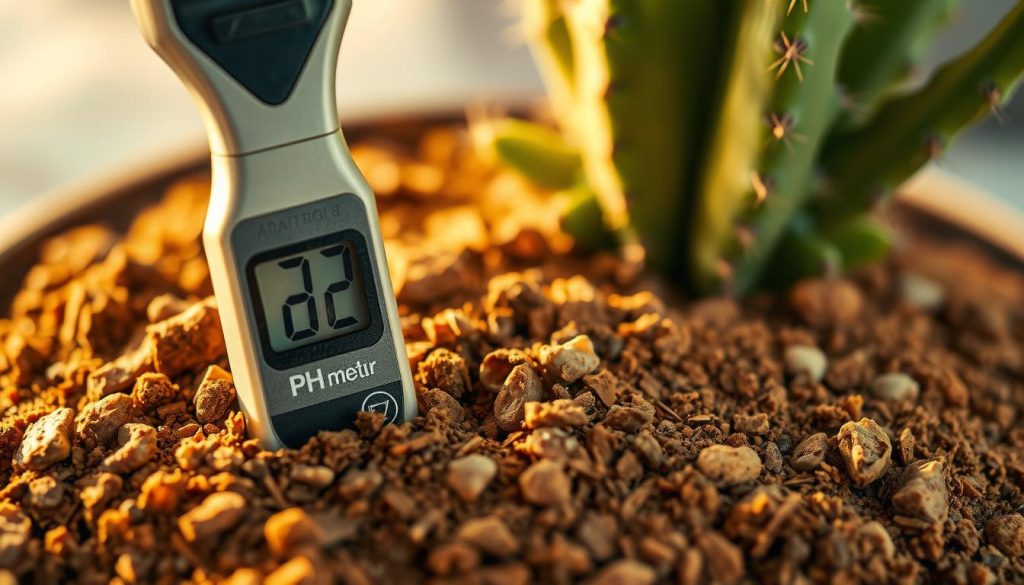
Cactus plants do best in slightly acidic to neutral soil. The best pH for most cacti is between 5.0 and 6.5. This helps them absorb nutrients well in dry soil.
Why pH Matters for Cacti
Soil pH affects how your cactus gets nutrients. If the pH is off, nutrients are hard for the plant to use. This can cause growth problems.
- Proper pH enables better nutrient absorption
- Supports root health in cactus potting mix
- Prevents nutrient lockout
How to Test Soil pH
Testing your cactus soil’s pH is easy. You can use simple home tests. Garden centers and online stores sell good pH testing kits.
- Purchase a soil pH testing kit
- Collect a small soil sample from your cactus pot
- Follow the kit’s instructions carefully
- Compare results with the recommended pH range
By checking and adjusting your soil’s pH, you can make a great home for your desert plants.
Adjusting Soil pH for Optimal Growth
Cactus lovers know that the right soil is key for healthy plants. The soil’s pH level affects how well cacti get nutrients. It’s important to manage soil pH for a good soil mix that helps cacti grow well.
Most cacti like soil that’s slightly acidic to neutral, between 6.0 and 7.5 pH. If the soil pH is off, plants may not get the nutrients they need, even with rich soil.
Using Lime to Increase pH
Too acidic soil? Agricultural lime can help. Here’s how to use it:
- Test your soil’s pH with a good testing kit
- Use finely ground agricultural lime for better absorption
- Start with small amounts to avoid big pH changes
- Mix lime well into your soil
Sulfur for Lowering pH Levels
For soils that are too alkaline, sulfur is a great fix. Here’s how to do it:
- Do a thorough soil pH test
- Choose elemental sulfur or aluminum sulfate
- Apply sulfur carefully to your soil mix
- Watch how your plants react after applying
Remember, making pH changes should be slow and small. Big changes can harm your cacti and their roots.
Store-Bought vs. Homemade Mix: Pros and Cons
Choosing the right soil for cacti can make a big difference for plant lovers. Gardeners must decide between buying a pre-made mix or making their own. This choice affects how well the plants grow.
There are many things to think about when making this choice. DIY soil has its own benefits that store-bought mixes can’t always offer.
Cost Comparison
Making your own cactus soil can save money over time. Here’s a look at the costs:
- Store-bought mixes cost $8-$15 per bag
- Homemade blend ingredients can be bought in bulk
- Starting with DIY costs less
- DIY mix can save 40-60% in the long run
Quality Considerations
Creating your own soil mix lets you control the ingredients. You can make the mix just right for your cacti.
- You can set the drainage just right
- Choose the best ingredients
- Adjust the minerals for your plants
- Avoid fillers found in store mixes
The decision between store-bought and homemade depends on your time, money, and gardening skills. Both ways can lead to great results if done well.
Common Mistakes to Avoid
Growing cacti needs special care that’s different from regular houseplants. Many gardeners make big mistakes that harm their desert plants. Knowing these common errors will help you make a great home for your cacti.
Choosing the right soil is key for cactus survival. Regular potting soil is bad for these desert plants. It holds too much water, causing root rot.
Overwatering Risks for Cacti
The biggest mistake gardeners make is overwatering. Cacti live in dry places and need little water. A sandy cactus compost helps keep water out, just like their natural home.
- Avoid watering on a fixed schedule
- Check soil moisture before watering
- Use a fast-draining cactus mix to prevent water accumulation
- Allow soil to completely dry between waterings
Choosing the Wrong Soil Type
Standard potting soil can hurt cactus roots by holding too much water. Special cactus soil mixes give the right drainage and air. These plants need it to grow well.
- Select soil with large particle sizes
- Ensure good drainage capabilities
- Mix your own well-draining substrate
- Avoid dense, moisture-retentive soils
By knowing these important points, you can make a perfect place for your cacti to grow. This will help avoid common mistakes in growing them.
Cactus Potting and Repotting Techniques
Keeping cacti healthy means knowing how to pot and repot them right. The soil you use is key to their health. Using the right mix ensures your succulents grow well.
It’s important to know when to repot your cactus. Most do well every 2-3 years or when they show certain signs.
Signs You Need to Repot
- Roots emerging from drainage holes
- Plant becoming too large for current container
- Soil breaking down or compacting
- Stunted growth or discoloration
Repotting Step-by-Step Guide
- Select a pot 1-2 inches larger than current container
- Prepare fresh succulent soil mixture
- Carefully remove cactus from existing pot
- Inspect roots and remove any damaged sections
- Place cactus in new pot with fresh desert plant soil
- Avoid watering immediately after repotting
Repotting needs care and knowing your cactus’s needs. Wear thick gloves and use tools to protect yourself from spines.
Fertilizing Your Cactus Potting Mix
Nourishing your cacti needs a smart fertilization plan. A good soil mix needs the right nutrients for growth. Knowing how to fertilize turns your soil into a great place for cacti to thrive.
Types of Fertilizers for Cacti
Choosing the right fertilizer is key for your cacti. Not all fertilizers are good for desert plants. Here are some options:
- Low-nitrogen organic fertilizers
- Specialized cactus nutrient blends
- Phosphorus-rich formulations
- Diluted liquid fertilizers
Fertilization Frequency Guidelines
Cacti need different nutrients than other plants. They grow best with minimal fertilization. Here’s what to do:
- Apply fertilizer in spring and summer
- Don’t fertilize in winter when they’re dormant
- Use half-strength fertilizer for most species
- Avoid fertilizing new or stressed plants
Organic matter in your soil helps with nutrient uptake. Regular but light fertilization keeps your soil balanced. This supports strong cactus growth without harming their roots.
Watering Tips for Cacti
Watering your cacti right is key to their health. These desert plants need special care with water. Knowing how much moisture they need can help them thrive.
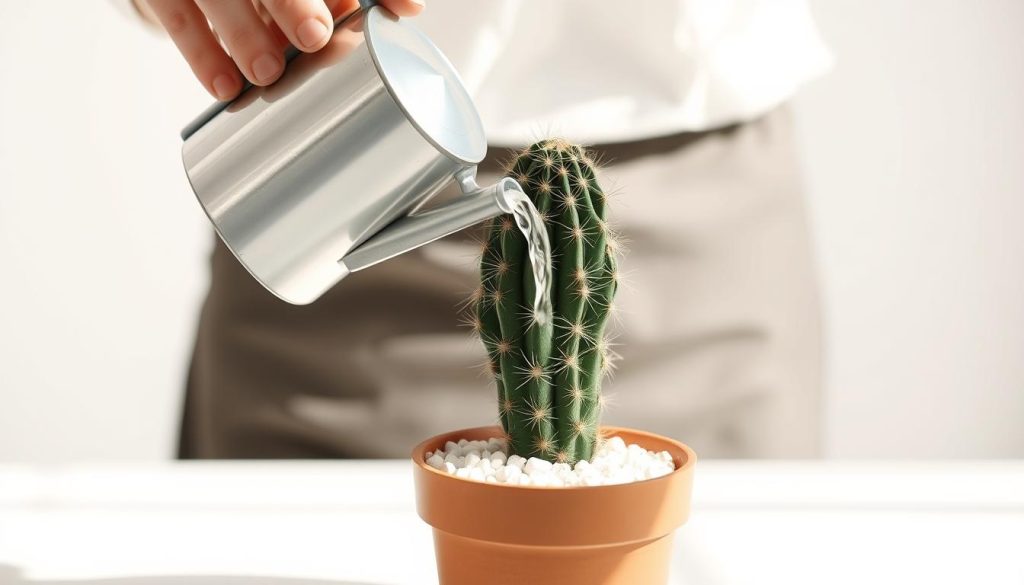
Cacti are experts at saving water, thanks to their desert home. The right soil helps keep water in and out. Spotting water problems early is important for their health.
Signs of Water Stress
- Underwatering indicators:
- Wrinkled or shriveled skin
- Significant loss of color
- Extremely lightweight pot
- Overwatering warning signs:
- Soft or mushy plant tissue
- Yellowing or translucent skin
- Visible root rot
Best Watering Practices
- Water deeply but infrequently
- Allow soil to dry completely between waterings
- Reduce watering during winter months
- Use room temperature water
- Water at the base of the plant
Try to match the cactus’s desert life. Watering less often helps roots grow strong. It also keeps diseases away from constant moisture.
Seasonal Care for Cacti
Caring for cacti means knowing their special needs all year. The seasons change how you care for your succulent soil and cactus mix. To grow cacti well, adjust your care to fit the weather.
Each season needs a different way to keep your cactus mix healthy. Cacti are tough, but they still need your help in harsh weather.
Adjusting Your Potting Mix for Seasonal Shifts
- Spring: Increase watering slightly as growth begins
- Summer: Ensure excellent drainage in your cactus potting mix
- Fall: Reduce watering and fertilization
- Winter: Minimize moisture in the succulent soil
Protecting Cacti During Extreme Weather
Extreme weather can stress your cacti. In hot weather, move them to a shaded spot. In cold areas, bring them inside or cover them up.
- Use frost cloths for winter protection
- Avoid placing cacti near heating or cooling vents
- Monitor humidity levels in your indoor environment
- Adjust watering frequency based on temperature changes
Understanding seasonal changes helps your cacti thrive all year. A good fast-draining cactus mix is essential for their health in every season.
Troubleshooting Common Issues
Keeping your cacti healthy means watching your desert plant soil and plant care closely. Pests and fungal infections can harm your succulents fast. So, spotting and stopping them early is key.
A good soil mix is your first defense against cactus problems. The right soil prevents moisture issues. These issues can attract pests and help fungi grow.
Identifying Pest Problems
Here are some pests that can harm cacti:
- Mealybugs: White, cottony clusters near plant bases
- Spider mites: Tiny web-like structures between spines
- Scale insects: Small, hard bumps on plant surfaces
Check your plants often for pests. Catching them early helps treat them better and stops damage.
Recognizing Fungal Infections
Fungal infections come from too much moisture in the soil. Look out for these signs:
- Dark, soft spots on cactus skin
- Unusual discoloration or mushy texture
- White or gray powdery coating
A soil mix that drains well and has good airflow helps fight fungi. Make sure your cactus gets enough light and doesn’t stay wet too long. This keeps it healthy.
Conclusion: Creating the Ideal Environment for Your Cacti
Starting a cactus garden means knowing how important the right soil is. It’s not just about soil; it’s about making a home that feels like the desert. By picking and mixing the right soil, you set your cacti up for success.
Growing cacti takes time, patience, and a love for learning. Each type of cactus needs something different. Finding the right mix of soil is key. It helps your cacti grow strong and beautiful.
For those into water-saving gardens, cacti are perfect. They do well in tough spots. With the tips from this guide, you can make a great space for these amazing plants.
Success with cacti is both science and art. By learning what they need, you’ll get healthy, vibrant plants. They’ll add desert charm to your garden or home.

